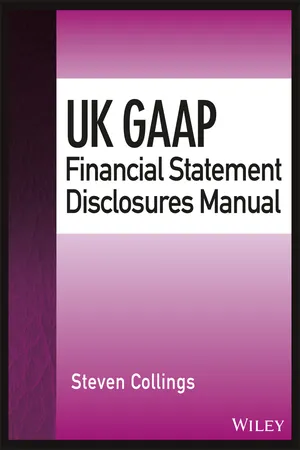
- English
- ePUB (mobile friendly)
- Available on iOS & Android
UK GAAP Financial Statement Disclosures Manual
About this book
UK GAAP Financial Statement Disclosures Manual is the practical handbook accounting professionals need to prepare audit-proof financial statements. The recent establishment of the new UK GAAP has brought significant changes to financial reporting, and this guide collects all of the latest guidelines into one place. Clear, concise and heavily geared toward practical application, this book is designed for easy navigation with stand-alone chapters and real-world examples. You'll find step-by-step guidance for the entire disclosure process, with explicit instruction on what to include, how to include it and why. Financial statements prepared from 2015/2016 in the UK and Republic of Ireland will appear significantly updated, and this manual gives you the guidance you need to understand what's required to achieve full compliance.
Insufficient or incorrect disclosures are frequently the reason why financial statements are rendered deficient. This book provides practitioners with a reference and guide for all aspects of financial statement disclosure preparation.
- Get up to speed on the most recent UK GAAP guidelines
- Understand the 'what' and 'why' of disclosure statements
- Study real-world example statements for practical guidance
- Prepare statements that stand up to auditor and regulator scrutiny
Many practitioners fall afoul of regulators' criticisms with subjective, incomplete, omitted or incorrect disclosures, resulting in sanctions being brought against the practitioner or the firm. Financial statement disclosure emphasis is on transparency at a time when changes in the profession require an entirely new method of preparation. For practitioners who need to stay ahead of the curve, UK GAAP Financial Statement Disclosures Manual is the invaluable reference to keep within arm's reach.
Frequently asked questions
- Essential is ideal for learners and professionals who enjoy exploring a wide range of subjects. Access the Essential Library with 800,000+ trusted titles and best-sellers across business, personal growth, and the humanities. Includes unlimited reading time and Standard Read Aloud voice.
- Complete: Perfect for advanced learners and researchers needing full, unrestricted access. Unlock 1.4M+ books across hundreds of subjects, including academic and specialized titles. The Complete Plan also includes advanced features like Premium Read Aloud and Research Assistant.
Please note we cannot support devices running on iOS 13 and Android 7 or earlier. Learn more about using the app.
Information
1
The Structure of UK GAAP
- Introduction
- FRS 102 The Financial Reporting Standard Applicable in the UK and Republic of Ireland
- The EU Accounting Directive
- Response by the Financial Reporting Council
- The Structure of New UK GAAP
- Key Points
Introduction
FRS 102 The Financial Reporting Standard Applicable in the UK and Republic of Ireland
The EU Accounting Directive
- simplify accounting requirements so as to reduce the administrative burden on companies with particular emphasis focused on smaller companies;
- increase the clarity and comparability of financial statements of companies so as to reduce the cost of capital and increase the level of cross-border trade and merger and acquisition activity; and
- protect essential user needs by retaining necessary accounting information for users.
- introduces a ‘building block’ approach to the statutory accounts whereby disclosure levels are increased depending on the size of the undertaking;
- reduces the number of options available to preparers in respect of recognition, measurement and presentation; and
- creates a largely harmonised small companies' regime and, for the first time, limits the amount of information which Member States are permitted to require small undertakings to place in their annual financial statements.
Table of contents
- Cover
- Title Page
- Copyright
- Foreword
- Preface
- Acknowledgements
- About the Author
- Chapter 1: The Structure of UK GAAP
- Chapter 2: Interaction of the Companies Act 2006
- Chapter 3: The Directors' Report and Strategic Report
- Chapter 4: The Income Statement/Statement of Comprehensive Income
- Chapter 5: Statement of Financial Position (Balance Sheet)
- Chapter 6: The Statement of Changes in Equity
- Chapter 7: The Statement of Cash Flows
- Chapter 8: The Auditor's Report
- Chapter 9: Accounting Policies, Estimates and Errors
- Chapter 10: Operating Segments
- Chapter 11: Directors' Remuneration Report
- Chapter 12: Taxation
- Chapter 13: Fixed Assets and Investment Property
- Chapter 14: Government Grants
- Chapter 15: Financial Investments
- Chapter 16: Financial Instruments
- Chapter 17: Leasing
- Chapter 18: Inventories
- Chapter 19: Provisions and Contingencies
- Chapter 20: Transactions with Directors
- Chapter 21: Events After the Reporting Period
- Chapter 22: Going Concern
- Chapter 23: Related Parties
- Chapter 24: Consolidated Financial Statements
- Chapter 25: Filing Financial Statements with Companies House
- Chapter 26: Interim Financial Reporting
- Chapter 27: Earnings Per Share
- Chapter 28: Financial Statements for Micro-Entities
- Chapter 29: Insurance
- Index
- End User License Agreement